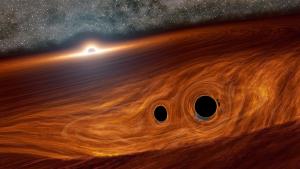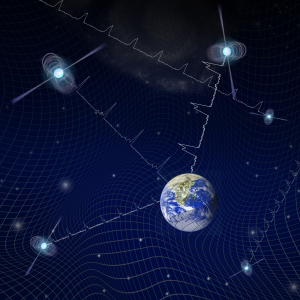Blog
The Long Wave
13 January 2021
 Caltech/R. Hurt (IPAC)
Caltech/R. Hurt (IPAC)Gravitational-wave astronomy is still in its infancy. LIGO and other observatories have opened a new window on the universe, but their gravitational view of the cosmos is limited. To widen our view, we have the North American Nanohertz Observatory for Gravitational Waves (NANOGrav).
Gravitational waves are created by the motion of massive objects. Most of the gravitational waves we’ve detected come from the merger of black holes. In their last moments, binary black holes orbit each other very quickly, producing rapid and strong gravitational waves. But most of the gravitational waves rippling through the universe are neither rapid nor strong. They are the faint echoes of orbiting black holes that aren’t about to merge. Their slow orbits create a background of gravitational waves. A single wave from one of these sources can take years to make a complete cycle.
 NANOGrav/T. Klein
NANOGrav/T. KleinTo detect these gravitational waves, NANOGrav observes radio pulses from rapidly rotating neutron stars known as millisecond pulsars. Most of these pulsars are very regular, so a shift change in their pulse rate is caused by a change in their motion relative to Earth. Essentially, NANOGrav is like LIGO but on the scale of our galaxy. But because these background gravitational waves oscillate so slowly, it takes years to observe a shift of the pulsars due to them.
NANOGrav has been watching pulsars for more than a dozen years, and they’ve just published some initial results.1 In the study, the team looked at 45 millisecond pulsars they know have very steady pulse rates. Some of them have been observed for 12.5 years, but all of them have been observed for at least 3 years. When they filtered out spurious noise effects, they found what appears to be a background signal of gravitational waves with an oscillation period of about a year. They can’t prove that gravitational waves are the origin of this signal, but they have ruled out other possibilities, including any bias in their data.
While a decade of observations seems like a long time, it’s just a moment in time for many of these gravitational waves. To understand them better we will need to keep watching for much longer.
Arzoumanian, Zaven, et al. “The NANOGrav 12.5 yr Data Set: Search for an Isotropic Stochastic Gravitational-wave Background.” The Astrophysical Journal Letters 905.2 (2020): L34. ↩︎